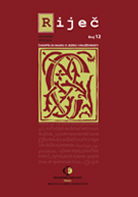STRUKTURIRANJE JUNAČKE SMRTI U ROMANU HAJKA
CREATING THE CULT OF SACRED DEATH IN THE NOVEL HAJKA
Author(s): Neda PapovićSubject(s): Language and Literature Studies
Published by: Filološki fakultet, Nikšić
Keywords: humanity and heroism; blessed sacrifice; heroism; identity model; illustrative type of referencing
Summary/Abstract: The article deals with the artistic transfer of Montenegrin heroism from Gorski vijenac (The Mountain Wreath) to the narrative world of Hajka(The Pursuit). It includes the study of all levels of meta textual interaction, starting from the construction of the ethical space of humanity and heroism, through the analysis of the symbolic system in Hajka, the characterization, the chronotopes, the motivation system, the types of citations from Gorski vijenac in Hajka, and, finally, its overall conceptual images of the world. Dealing with the relationship between Hajka and Gorski vijenac, the author came to the conclusion that there is an illustrative type of referencing, which means that Lalić utilized Gorski vijenac as a sample text, drawing inspiration from itand taking certain elements and transferring them to Hajka. Using Njegoš’s citations, Lalić showed an unsurpassable talent in their transformation. No citations are superfluous; they are very functional, giving depth in meaning to those layers of Hajka where we find them. However, in this research process, it was very challenging to identify Njegoš’s citations in Hajka, especially the implicit ones. The fact that we encounter explicit citations from Gorski vijenac in Hajka encourages a careful reader to search for the hidden ones, which can be contained in the construction of a certain spatial structure of Hajka, a toponym, the ambience of the novel, in the dialogue of characters, their spatial placement, personal traits of a character, his inner monologue, actions, movement and overall motivation. If the theme of Gorski vijenac can be defined as a literary reconstruction of the Montenegrin socio-cultural code, then Hajka could also be understood as a certain description of the Montenegrin identity model. It becomes a guardian of the archaic message of the “Heroic Bible”, not its creator. Here, the illustrative meta textual pattern is realized as a powerful literary tool for mythologizing the ideals of the Montenegrin nation: humanity and heroism, and in the broadest sense, Montenegrin philosophy of heroism, specific in relation to the notion of heroism in general. In Montenegrin literary, theoretical and critical thought, there is an abundance of literature dealing individually with works of Njegoš and Lalić, in particular Gorski vijenac and Hajka. However, there is insufficient literature identifying the meta textuality existing in these works, which reveals that Hajka has not been comprehensively deconstructed in theory. The aim of this study is, therefore, to find out the meaning of the dialogue of the above-mentioned works, doing so through a multidisciplinary approach required by the specificity of the moral code of humanity and heroism, the cult of the blessed sacrifice and the sacred death, and the unusual ambience created by the Montenegrin philosophy of heroism.
Journal: Riječ
- Issue Year: 2015
- Issue No: 12
- Page Range: 57-81
- Page Count: 25
- Language: Serbian

